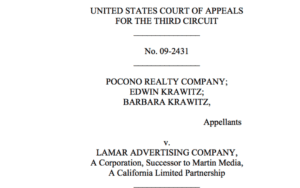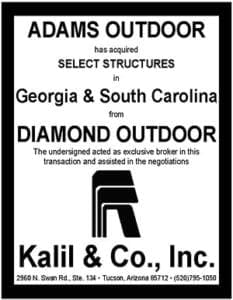 Outdoor land leases and easements are long term agreements. Landowners have a way of forgetting exactly what’s in a lease or easement agreement with the passage of time. Pocono Realty v Lamar demonstrates how a well written easement can protect you when your landlord has a fuzzy memory.
Outdoor land leases and easements are long term agreements. Landowners have a way of forgetting exactly what’s in a lease or easement agreement with the passage of time. Pocono Realty v Lamar demonstrates how a well written easement can protect you when your landlord has a fuzzy memory.
- In 1998 Pocono Realty company sold certain assets and easements relating to three billboards to Martin Media, which subsequently became Lamar. The purchase and sale agreement was quite clear:
1 Purchase and Sale of Assets and Easements. Seller agrees to sell, purchase, transfer, assign and deliver to Buyer and Buyer agrees to purchase form Seller all of Seller’s right, title and interest in and to the Assets…
1.1 In addition to the Assets Buyer shall purchase from Seller and Seller shall sell to buyer permanent easements for the placement, operation and maintenance of specified outdoor advertising structures on the real property of Seller…The Easemetns shall include unrestricted access rights to each of the Boards for construction, maintenance, operation and utilities, and the real property upon which the Boards are not located shall be subject in perpetuity to such Easements.
- The accompanying Easement was just as detailed.
- In November 2007 Pocono Realty asked Lamar to start paying rent on the three billboards. Lamar denied, saying that use of the land was within the scope of its easements.
- In December 2007 Pocono Realty filed suit in court contending that the easements only concerned passage to the boards but not the right to use the land and that Lamar needed to start paying rent for the land.
- A lower court and appeals court found in favor of Lamar. The Court ruled that the documents were clear: “Section 1.1 of the Agreement belies Plaintiff’s attempt to separate the right to access the boards from the right to use the land under the boards. That provision explicitly provides that “the real property upon which the Boards are now located shall be subject in perpetuity to such Easements.”
- In addition the Court found that the parties conduct in the ten years following execution of the agreement supported the idea that the easement was for use of the real estate and not just for passage to the boards:”The parties’ conduct further confirms this conclusion. It has been nearly ten years since the Agreement was executed. Plaintiffs have never before demanded rent from Lamar…Their behavior between January 1998 and November 2007 is certainly a convincing demonstration of [their]interpretation of the contract.
Insider’s take: Memories can change but good legal documents last forever. The case also shows how courts take actions into account in interpreting what agreements mean. If you act for 10 years like a lease or easement means one thing and then change your interpretation a court will be skeptical.
Paid Ad

















